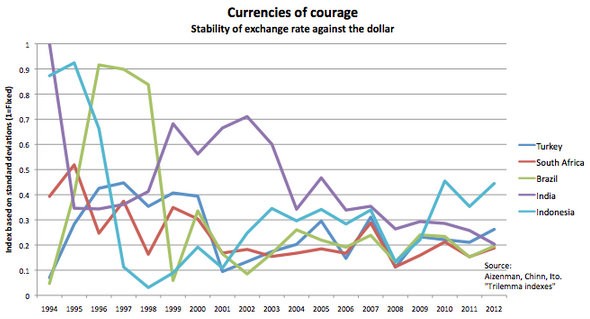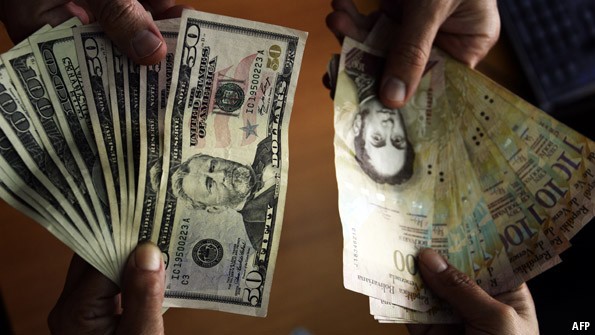Floating v exchange rate debate has no right answer
Post on: 29 Апрель, 2015 No Comment

November 25, 2012 12:15 am By EDWARD LOTTERMAN
Economists long have argued about whether it’s better to have fixed or floating exchange rates.
When the world no longer was on the gold standard with its inherently fixed exchange values, but still on the post-World War II Bretton Woods system of fixed rates, some economists, including the conservative Nobel laureate Milton Friedman, argued that free-floating rates would be better for the global economy.
The traditional argument for fixed rates was that they reduced uncertainty for importers and exporters, thus facilitating commerce. They also took the risk of rate fluctuations out of investing in other countries by, for example, building a factory in another nation or buying stocks and bonds there.
Advocates of floating rates argued that they would foster greater economic efficiency. Market forces would provide incentives for economically “correct” rates that would bring about optimal levels of trade and investment.
However, 40 years after the Bretton Woods system collapsed, living with floating rates is far more complicated than its advocates anticipated.
It is not clear there were great efficiency gains, and there well may be greater instability for financial systems.
Fluctuations, largely driven by interest rate differentials and expectations within large financial firms, certainly make life more complicated for bread-and-butter importers and exporters and for corporations that have considerable business operations overseas.
At the same time, the ongoing debacle in the Eurozone demonstrates that going to a single multinational currency — fixed rates taken to an extreme — has even worse problems.
In the meantime, small nations, like Switzerland, New Zealand, Singapore or even the tiny island nation of Barbados, where I vacationed recently, face practical challenges in exchange rate policies. Their responses give insights on our own problems.
Like some other small nations, Barbados has chosen unilaterally to fix the value of its dollar to a major foreign currency.
In doing this, Barbados opted for stability and predictability in trade. As a small nation, the ratios of both its exports and its imports to gross domestic product are far higher than for large industrialized nations like ours.
When choosing to fix, however, Barbados faced a difficult choice. Most of their imports come from the United States, although they do import machinery and vehicles from Asia.
Some of its imports from the United States are actually items manufactured in Asia, but purchased in relatively small lots from U.S. intermediaries.
However, most tourists in Barbados come from Europe and tourism is the largest single sector of the economy.
If they fixed their currency to the British pound or the euro, prices of imports from the United States would fluctuate as the U.S. dollar varied against the pound or Euro. But the cost of tourism for their U.K. or continental customers would not change from year to year.
By instead fixing to the dollar, importers know what they will have to pay for purchases from the United States, but the competitiveness of Barbados tourism can vary widely to its usual European clientele.
They chose to fix to the dollar.
And that, on occasion, has put Barbados’ tourist businesses on a roller coaster. When the Euro lost a third of its value against the dollar in the first years after its introduction in 1999, Barbados tourism suddenly became very expensive for customers from France, Germany, the Netherlands and Finland.
This was harsh for the businesses affected. But when things reversed and the U.S. dollar fell in value against the Euro and the pound, Swiss franc and Swedish Kroner, the same businesses boomed.
Now, over the past two years, as the dollar once again has gained value compared with the euro, the number of Eurozone customers again is slackening.
Linking to the dollar imposed harsh constraints. Anytime a nation fixes an exchange rate, it is making an open-ended commitment to buy and sell the nation’s currency at the stated rate.
In other words, every time someone comes to the Barbados Central Bank with a U.S. dollar, it must be prepared to hand over two Barbados dollars in exchange. And every time someone comes with two Barbados dollars, it must hand over one U.S. dollar.
If interest rates rose in the United States compared with Barbados, savers would want to exchange their Barbados money for U.S. so they could take advantage of higher U.S. interest rates.

At some point, the Central Bank could run out of U.S. dollars. The country would then be unable to pay for food and fuel imports. To avoid this, Barbados would have to raise its own interest rates to pull money back.
Conversely, if interest rates are high in Barbados compared with the United States, or if our Federal Reserve cuts rates and the Central Bank of Barbados does not, U.S. dollars will flow to Barbados to take advantage of the higher rates there.
The Barbados Central Bank can always print more Barbados dollars to hand out in exchange for the additional U.S. dollars flowing in. But that can be inflationary.
(The situation is more complicated since Barbados has “exchange controls” or administrative regulations that limit anyone’s ability to move capital in and out of the country at will.)
Indeed, any time our country allows higher inflation over an extended period, Barbados will have to “import” that inflation or increase the value of their dollar by fixing a new rate.
That will make buying from us cheaper for their importers, but it will make the dollar price of their exports more expensive, thus curtailing them.
Barbados has never faced such an influx of a foreign currency that its exports were priced out of world markets. But that is precisely the situation Switzerland has faced over the past two years as savers in the Eurozone strove to preserve their money in the event of a euro meltdown by moving it into Swiss francs deposited in Swiss bank accounts.
The flood of money into Switzerland threatened to drive up the value of the Swiss franc.
This would be disastrous for the Swiss machinery and high-tech manufacturers that export nearly all their production.
The Swiss central bank responded by drastically increasing the number of francs in circulation. This kept the value of the franc from rising, but sharply increased the possibility of a surge in the Swiss inflation.
Over the years, similar stresses from exchange rate fluctuations have assailed the U.S. economy, but because it is so large and complex, most people don’t pay attention to it. That may change as our economy continues to shrink in size compared with the rest of the world.
(Economist Edward Lotterman teaches and writes in St. Paul, Minn. Write him at ed@edlotterman.com.)














